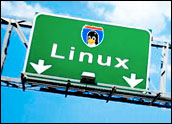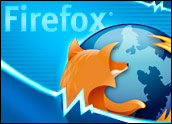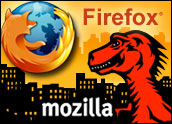
Much the same as any other open-source debate, opinions about the future of Linux on the desktop are about as varied as they come.
On one side you’ve got the Desktop Linux Consortium with its mission to advance the open-source operating system on desktops everywhere. On the other side you’ve got software giants adamantly opposed to its spread.
Gartner issued a report recently that has stirred up some debate among industry watchers. In it, Gartner says that Linux is still very much struggling for mainstream desktop acceptance and offers plenty of data to back it up.
According to Gartner, just over 1 percent of companies were running Linux desktops and open-source office products in the fourth quarter of 2004. What’s more, Gartner estimates that only 3.2 percent of non-consumer computer users will run Linux and open-source office products by 2008.
Does this suggest Linux-based apps have hit a plateau or standstill? Or might it mean that open-source companies are simply challenged to improve products, marketing, and userability for desktop applications?
Scaling a Mountain
Greg Mancusi-Ungaro, Novell’s director of marketing for Linux and open-source products, told LinuxInsider that open-source products have far from reached a desktop plateau.
“Novell sees a lot of excitement and interest from companies that are looking at segments of their populations where these specialized desktops are in play,” Mancusi-Ungaro said. “Linux is seeing a lot of action there.”
Mancusi-Ungaro is talking about shop floors, transactional machines, call centers, kiosk applications, and machines running inventory applications.
“We have a broad definition of desktop computing,” Mancusi-Ungaro explained. “People often don’t think of transactional machines as desktops, they think of machines on which you run PowerPoint or Photoshop.”
Pushing the Marketing Envelope
Gupta CTO Chuck Stevenson agrees that the Gartner data does not suggest Linux-based applications have hit a standstill. However, he told LinuxInsider that it does suggest the burst of the “hype bubble.”
“When Novell rolled out the Novell Linux Desktop and the SuSE professional product lines, the advertising message was that they could completely replace the Windows desktop,” Stevenson said. “This was a major mistake. Microsoft Windows will continue to be the dominant desktop for at least the next decade.”
Novell’s Mancusi-Ungaro prefers to think of the battle as the challenge of building marketing inertia. Microsoft has had the corner on the desktop market for so many years and overcoming that mindset is a major obstacle for Linux and open-source apps. He said he is encouraged that Vista is coming to market.
“Lotus 123 had the spreadsheet market locked up until there was Windows,” Mancusi-Ungaro recalled. “When everyone had to shift to Windows they began to look around and see what else was on the market.”
Mancusi-Ungaro’s theory is that forced migrations give rise to evaluations and evaluations will cause many companies to take a close look at what Linux can do. His prediction: The market will find the percentage of companies that adopt Linux for some of their desktops will go up in the next few years.
Improving Userability
Perry Donham, a lead technical consultant with Collaborative Consulting, told LinuxInsider that the success of open-source developers in creating Microsoft work-alikes is, in part, the reason for slow adoption of Linux on the desktop.
“There is now very little to differentiate Linux on the desktop from Windows. The major productivity suites are designed so that it really doesn’t make a difference to end-users if they run Word or OpenOffice,” Donham reasoned.
“For average users, it appears that Linux innovation has stopped; we’re left with something that looks just like Windows. This was for the most part intentional. The applications’ look and feel mimic Windows to allow for easy transition to Linux.”
Donham figures corporate IT departments will purchase support for their desktops, whether the computers run Linux or Windows. And since there’s no killer app on the Linux desktop, he continued, there’s no compelling reason to migrate away from a Windows base, even if it means slightly higher TCO for the desktop machines.
“Certainly Linux is attractive in the server room,” Donham said, “but the great success of the Linux desktop, making itself comfortable for Windows users, has, I believe, also become its stumbling block.”
Mancusi-Ungaro, however, said to expect some usability breakthroughs. He said Linux is not burdened by the legacy of a massive existing user base and therefore has the freedom to innovate.
Pursuing Growth Potential
There is growth potential in Linux desktop/clients in the area of task-specific computing and Point of Sale (POS) solutions.
“There are many areas where Linux is beneficial, including charitable organizations, governments and schools where cost is the main concern,” Stevenson said. “In summation, Linux desktop/client adoption is neither slowing down nor hitting a plateau.”
Some open source companies are, however, hitting roadblocks, like the ability to provide commercial-quality support and a compelling roadmap within a reasonable time frame. Then there’s the growing realization that open source is not actually free.
Stevenson said there a number of stories about companies committing to open source in 2003 or 2004 that are now poster children for Microsoft because they found the open-source path was far more expensive than commercial software.
“Open source becomes particularly expensive when there is a defect in the application and business is shut down for two weeks while the IT department tries to sort through the reams of source code to identify the problem and the open-source provider won’t address the defect in a timely fashion,” he said.
While the risks of open-source applications are becoming more recognizable, analysts said there are still a number of commercial products that run on Linux and create a higher comfort level for businesses who know they can get products fixed, receive regular updates, and have access to a compelling technical plan.
Stevenson said more and more open source companies are becoming ever more commercial and charge licensing fees to ensure that they can provide proper support and produce predictable technical roadmaps that businesses can rely on.
“There is going to be quite a stir over this, but the almost religious fervor over open source and Linux has to be moderated by people who see the value of Linux in specific computing solutions and don’t have a ‘kill Microsoft’ mentality,” he said. “This will help ensure that businesses choose the best operating system for the problem they are solving at the time.”
In Conclusion
In part, adoption of Linux on the desktop has been sluggish until this point because of its reputation and nature as being rather “hobbyist.” As its professional image becomes more positive, more headway is expected to be made. Interarbor Solutions analyst Dana Gardner told LinuxInsider that Gartner’s report does predict triple growth for Linux on the desktop by 2008 — a rapid ascension even in a small market.
Gardner said much of the open-source growth issue ties into Microsoft Office, as OpenOffice and Linux are interdependent when it comes to gaining popularity. While Novell and Sun have made strides to bring a user-friendly product that is easy to migrate, two possible Microsoft moves could change the landscape.
According to Gardner: “Microsoft is going to an XML format for Office outputs, which would make interoperability with other applications more straightforward. At the same time, Microsoft is refocusing on Office as a cornerstone of its business. Microsoft is going to be very tenacious about Office as software that ties into the rest of its product line and will become extremely diligent about the marketplace for Office.”



















































